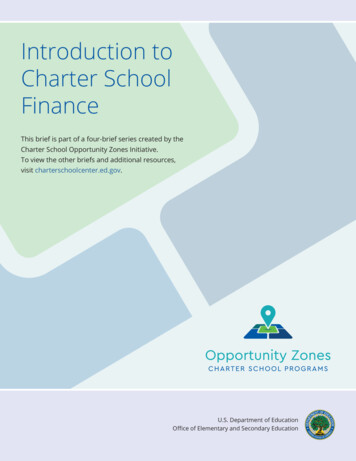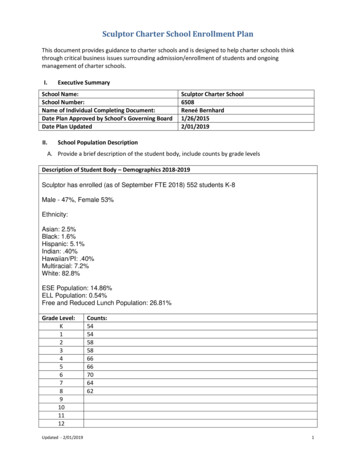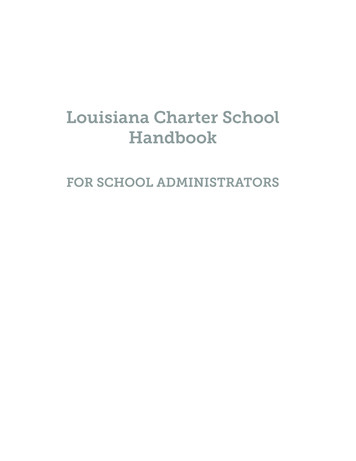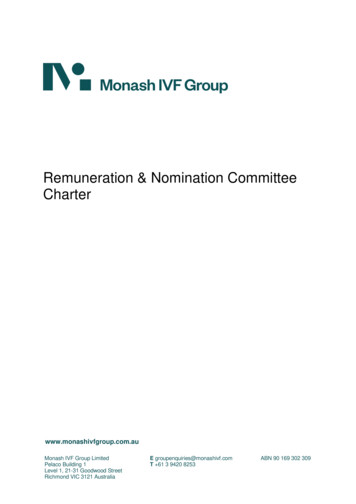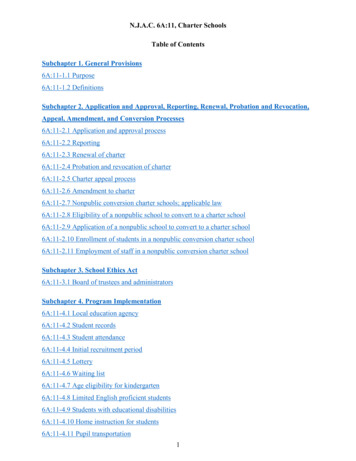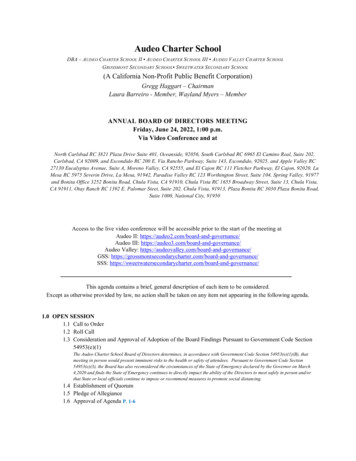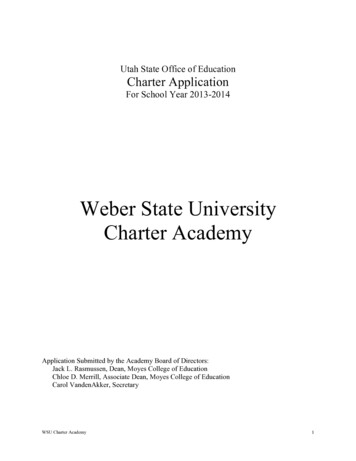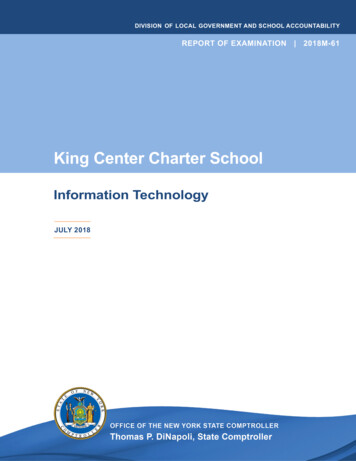
Transcription
DIVISION OF LOCAL GOVERNMENT AND SCHOOL ACCOUNTABILITYREPORT OF EXAMINATION 2018M-61King Center Charter SchoolInformation TechnologyJULY 2018
ContentsReport Highlights . . . . . . . . . . . . . . . . . . . . . . . . . . . . . 1Information Technology. . . . . . . . . . . . . . . . . . . . . . . . . . 2What Is Effective Information Technology Governance? . . . . . . . . 2The Board and School Officials Have Not Established SufficientIT Policies and Procedures . . . . . . . . . . . . . . . . . . . . . . . 3The School’s Technology Plan Does Not Establish Safeguardsfor IT Assets . . . . . . . . . . . . . . . . . . . . . . . . . . . . . . . 3The School Does Not Have a Complete or Reliable Inventory List. . . 4The School Has Insufficient Access Controls. . . . . . . . . . . . . . 4Computer Scans Indicate Inappropriate or Questionable InternetUse. . . . . . . . . . . . . . . . . . . . . . . . . . . . . . . . . . . . 5What Do We Recommend? . . . . . . . . . . . . . . . . . . . . . . . 6Appendix A – Response From School Officials . . . . . . . . . . . . . 8Appendix B – Audit Methodology and Standards . . . . . . . . . . . 10Appendix C – Resources and Services. . . . . . . . . . . . . . . . . 12
Report HighlightsKing Center Charter SchoolAudit ObjectiveDetermine whether information technology (IT) assetsare properly safeguarded, secured and accessed forappropriate School purposes.Key FindingsllThe Board has not adopted adequate IT securitypolicies and School officials do not have formalprocedures to address breach notification,disaster recovery, data backup, password securitymanagement, IT asset inventory and user accessrights.llWe identified inappropriate or questionablecomputer use on six computers.In addition, sensitive IT control weaknesses werecommunicated confidentially to School officials.Key RecommendationsllllAdopt written IT policies and procedures toaddress breach notification, disaster recovery,backups, password security management, ITasset inventory and to address individual useraccess rights.Provide IT cybersecurity awareness training topersonnel who use the School’s IT resources.In addition, we confidentially communicated key ITrecommendations to School officials.School officials agreed with our recommendations andindicated they planned to initiate corrective action.BackgroundThe King Center Charter School(School) is located in the City ofBuffalo. The School is governedby a Board of Trustees (Board)composed of 11 Trustees and threeparent representatives. The Board isresponsible for the general oversightof School operations. The Principalis the School’s chief executive officerand is responsible, along with otheradministrative staff, for the School’sday-to-day management under theBoard’s direction. The IT Directoris responsible for day-to-day IToperations and reports to the Directorof Finance and Operations (Director).Quick Facts2017-18 BudgetedAppropriationsEmployeesStudents 5.9 million78450Audit PeriodJuly 1, 2016 – December 8, 2017For certain audit tests, we expandedour testing back to May 4, 2013.Of f ic e of t he New York State Comptroller1
Information TechnologyThe School relies on its IT system for Internet access, email, and maintaining andaccessing personal, private or sensitive information (PPSI)1 including financial,personnel and student records. Therefore, the IT systems and data are valuableSchool resources. If IT systems are compromised, the results could requireextensive effort and resources to evaluate and repair. While effective controls willnot guarantee the safety of an IT system, a lack of effective controls significantlyincreases the risk that data, hardware and software systems may be lost ordamaged by inappropriate access and use.What Is Effective Information Technology Governance?To provide effective governance of IT operations and minimize the risk of a PPSIcompromise:llThe Board should:¡¡ Establishcomputer policies that take into account people, processes andtechnology; communicate the policies throughout the School; and ensureSchool officials develop procedures to monitor compliance with policies.¡¡ Ensurethe IT Director maintains detailed, up-to-date inventory recordsfor all computer hardware and software. The information maintained foreach item should include a description including the make, model andserial number and the employee (or student) name to whom the item isassigned.llSchool officials should:¡¡ Developand communicate written procedures to grant, change andterminate access rights to networked computer systems and specificsoftware applications. Passwords should be held to certain requirementsto make passwords more difficult to crack or be guessed. Criteria couldinclude complexity requirements, length, aging, reuse of old passwordsand also address failed log-on attempts.¡¡ Developand provide periodic IT cybersecurity awareness training thatexplains the proper rules of behavior for using the School’s IT systemsand data and communicate the School’s policies and procedures thatneed to be followed.1 PPSI is any information which – if subjected to unauthorized access, disclosure, modification, destructionor disruption of access or use – could severely affect critical functions, employees, customers, third parties orresidents of New York State in general.2Of f ic e of t he New York State Comptroller
The Board and School Officials Have Not Established Sufficient ITPolicies and ProceduresThe Board has not adopted a policy for notifying students and staff, in the eventthere is a PPSI compromise or breach. Further, the Board has not adopted acomprehensive disaster recovery plan to describe how officials will respond topotential disasters, which could include sudden, unplanned catastrophic events(e.g., fire, computer virus or inadvertent employee action) that compromise thenetwork and financial system availability or integrity and any PPSI containedtherein. Typically, a disaster recovery plan involves the analysis of businessprocesses and continuity needs, a focus on disaster prevention, the roles ofkey individuals and the precautions necessary to maintain or quickly resumeoperations.Also, the Board did not adopt a policy and officials did not develop writtenprocedures to provide guidance on data backups that define the frequency andscope of backups, the location of stored back-up data and the specific methodfor backing up data (e.g., encryption). Even though the IT Director backs up dataat regular intervals, he does not verify that the data has been properly backed upand can be restored.Further, the Board did not require and the IT Director did not routinely provideperiodic report updates to the Board addressing actual and potential issuesaffecting the School’s IT assets, such as IT inventory updates, current trendsin cybersecurity awareness and resources needed and applied to maintain theSchool’s IT system.Without established policies and formal written procedures addressing notificationof a breach of PPSI, disaster recovery, data backups and periodic reporting to theBoard, there is an increased risk that the School could lose important financialdata and suffer serious interruption in operations.The School’s Technology Plan Does Not Establish Safeguards for ITAssetsThe Board adopted a long-term technology plan (Plan) which outlines anevaluation process, including the establishment of a technology plan committee(Committee) that is responsible for formally evaluating the Plan twice eachyear. However, the Board has not established the Committee. Instead, the Planis periodically reviewed by the Director and the IT Director and included in theSchool’s charter renewal. Additionally, while the Plan addresses how students willuse IT for educational purposes, the Plan does not indicate how IT assets will bephysically safeguarded from theft or misuse. Staff and students annually receivea reminder of acceptable use policies for IT assets. However, without appropriateoversight and monitoring, the risk of inappropriate computer use is increasedwhich could compromise the IT system data, including PPSI.Of f ic e of t he New York State Comptroller3
The School Does Not Have a Complete or Reliable Inventory ListThe Board has not adopted a policy and officials have not developed writtenprocedures for maintaining an IT asset inventory. Although the IT Directorprovided us an inventory list that he maintained, it was not accurate or complete.During our IT asset physical examination, we found two projectors and 18wireless access points2 in use that were not on the IT Director’s inventorylist. Further, we selected 13 of 50 computers listed on the inventory that wereassigned to employees and found three which did not have serial numberslisted on the inventory list. As a result, the IT Director could not demonstratewith certainty that those three computers were in fact properly assigned to therespective employees. Moreover, while each employee generally signs a “loan ofequipment” form (form) when the IT Director assigns a computer, we found thatone computer was not the same computer for which the employee had signedand subsequently presented to us for our review. The IT Director could notaccount for the computer that the employee indicated was received on the form.Additionally, in 2014, the School reported 88 laptops as stolen. However, wefound that the serial numbers of 18 of the reported stolen laptops were stillincluded on the IT inventory list. Of these 18, we included nine in our inventorytesting and found that seven were currently being used by the School. Due to theinaccurate and incomplete inventory list, the current IT Director and officials werenot aware that this was the case.The Board and School officials cannot properly protect IT assets and operationsif they do not know what IT resources they have. Because neither the previousnor the current IT Director maintained a detailed, up-to-date inventory record, theSchool remains at an increased risk of loss.The School Has Insufficient Access ControlsThe Board has not adopted a policy and School officials have not developedcomprehensive written procedures for establishing, modifying or deleting useraccounts or appropriate controls over passwords (e.g., complexity requirements,password age). The IT Director is responsible for establishing user accountsand authorizing network access. Without adopted policies and procedures formonitoring and revoking user access rights, officials did not have an effectiveprocess in place to notify the IT Director of changes to employees’ employmentstatus. Inactive user accounts increase the risk for attacks on the School’snetworks.2 A wireless access point is a networking hardware device that allows a Wi-Fi device to connect to a wirednetwork.4Of f ic e of t he New York State Comptroller
We found that the network had 16 inactive user accounts that have not beenused in over six months, six of which were never used. In addition, five ofthe accounts were unnecessary and five were for students that are no longerenrolled at the School. Unnecessary network user accounts should be disabledor removed as soon as they are no longer needed to decrease the risk ofunauthorized access and potential entry points for attackers to copy, manipulateor delete PPSI. Of particular risk are user accounts for former employees, asthese could potentially be used by those individuals for malicious activities.Further, unnecessary accounts create additional work to manage access, alongwith the risk of errors that could result in users being inadvertently granted moreaccess than needed.Computer Scans Indicate Inappropriate or Questionable Internet UseInternet browsing increases the likelihood that users will be exposed to someform of malicious software that may compromise PPSI. The School’s acceptableuse policy states that it prohibits the use of computers for non-educational orillegal purposes, while the School’s Internet use policy specifically prohibits usingSchool resources for gambling.We examined web history and Internet use on six computers for a total of fourteachers, the IT Director and the Director and determined that all six engaged ininappropriate and/or questionable Internet use such as: online shopping, travelplanning, social networking and gambling websites.Teachers are allowed to take their assigned computers home throughout theyear, including over the summer when classes are not in session.3 Whencomputers are not connected to the network, they do not have the securitycontrols in place, such as firewall protection, and therefore are at a greater riskof virus, hacking or a breach.The School’s acceptable use policy is part of the employee handbook that eachemployee signs when they are hired. Our scans identified two user profilesthat had indications of malicious software and potentially unwanted programs.However, the IT Director and other officials were unaware of this because theydo not monitor employee Internet use or firewall activity. In addition, the Schooldoes not provide cybersecurity training to staff. Not providing cybersecuritytraining to employees increases the risk that users will not understand theirresponsibilities, putting the School’s data and IT assets at greater risk forunauthorized access, misuse or abuse. As a result, IT assets and any PPSIcontained therein are at higher risk of exposure to breach, loss, misuse ordamage.3 School officials indicated this allows teachers to plan and prepare work for their upcoming classes.Of f ic e of t he New York State Comptroller5
What Do We Recommend?The Board should:1. Adopt written IT policies to address breach notification, user accessrights, disaster recovery, data backups, password security managementand IT asset inventories.2. Periodically review and update all IT policies to reflect changes intechnology and the School’s computing environment.3. Establish the Committee in accordance with the Board’s long-termtechnology Plan and update the Plan to address how IT assets will bephysically safeguarded from theft or misuse.4. Ensure School officials develop and provide IT cybersecurity awarenesstraining at least annually to personnel who use the School’s IT resources.The IT Director and School officials should:5. Develop detailed written procedures that supplement adopted IT policies.6. Provide periodic reports to the Board so that it can provide sufficientoversight of IT operations such as, potential and actual issues affecting ITassets and PPSI contained therein, updates made to the IT system andinventory adjustments.7. Update and maintain a reliable and complete inventory of IT assets.8. Follow-up on the IT inventory issues noted in this report and determinewhether the original report of 88 stolen laptops is accurate and whetherthere are any additional unaccounted-for laptops that should be reportedto the proper authorities.9. Evaluate all existing network user accounts, disable or remove anydeemed unnecessary and periodically review user accounts for necessityand appropriateness.10. Provide adequate oversight of Internet use and firewall activity to ensureuse is in accordance with Board policies.6Of f ic e of t he New York State Comptroller
11. Evaluate the security of IT assets that are removed from School premises(e.g., laptops taken home for the summer) and ensure sufficient securitymeasures are in place.12. Prepare and annually provide IT cybersecurity awareness training topersonnel who use School IT resources.Of f ic e of t he New York State Comptroller7
Appendix A: Response From School Officials8Of f ic e of t he New York State Comptroller
Of f ic e of t he New York State Comptroller9
Appendix B: Audit Methodology and StandardsWe conducted this audit pursuant to Article V, Section 1 of the State Constitutionand the State Comptroller’s authority as set forth in Section 2854 of the New YorkState Education Law, as amended by Chapter 56 of the Laws of 2014. To achievethe audit objective and obtain valid audit evidence, our audit procedures includedthe following:10llWe obtained and reviewed Board policies and minutes, School proceduresrelated to IT operations and assets and interviewed School officials to obtainan understanding of the IT environment.llWe interviewed the IT Director regarding the School’s procedures formaintaining an IT inventory and then obtained the current IT inventory reportand compared it to recent IT purchases and physical inventory to determinewhether it was accurate and complete.llWe interviewed the Director regarding any police reports or insurance claimsthe School has filed reporting any stolen or missing IT assets. We thenobtained from the Director the 2014 police report and insurance claim filedreporting 88 stolen laptop computers. We compared this information withthe current IT inventory list to determine whether the IT inventory list wasupdated accordingly. We noted that the serial numbers for 18 of these 88laptops were still on the IT inventory. As such, we judgmentally selected half(50 percent) of the 18 laptops and nine laptops that were previously reportedas stolen and sought to locate them while performing a physical IT inventory.llWe interviewed School officials about the process followed, includingwhether there were any written guidelines or procedures, for granting accessto the School’s network, reviewing specific access and permissions grantedto individual users and removing and modifying permissions in a timelymanner.llWe provided an audit script to the IT Director on a universal serial busdriver to run on a judgmentally selected sample of six laptop computers. Weanalyzed each report generated by the script, looking for potential issuesincluding Internet browsing histories for personal and high-risk activities. Ourjudgmental sample selection was based on employee job titles and length ofemployment with the School. Our sample of laptop computers included fourteachers who have been employed by the School for over two years and twoadministrative staff.llWe obtained a list of all School network users and compared it to currentpayroll reports and student enrollment reports to determine whether anyusers were not currently employed or enrolled with the School.llWe interviewed School officials to determine whether employees receivedcybersecurity awareness training or reviewed acceptable use policiesregularly.Of f ic e of t he New York State Comptroller
Our audit also examined the adequacy of certain information technology controls.Because of the sensitivity of some of this information, we did not discuss theresults in this report, but instead communicated them confidentially to Schoolofficials.We conducted this performance audit in accordance with GAGAS (generallyaccepted government auditing standards). Those standards require that weplan and perform the audit to obtain sufficient, appropriate evidence to provide areasonable basis for our findings and conclusions based on our audit objective.We believe that the evidence obtained provides a reasonable basis for ourfindings and conclusions based on our audit objective.Unless otherwise indicated in this report, samples for testing were selectedbased on professional judgment, as it was not the intent to project the resultsonto the entire population. Where applicable, information is presented concerningthe value and/or size of the relevant population and the sample selected forexamination.The Board has the responsibility to initiate corrective action. We encourage theBoard to prepare a plan of action that addresses the recommendations in thisreport and forward the plan to our office within 90 days.Of f ic e of t he New York State Comptroller11
Appendix C: Resources and ServicesRegional Office Directorywww.osc.state.ny.us/localgov/regional directory.pdfCost-Saving Ideas – Resources, advice and assistance on cost-saving x.htmFiscal Stress Monitoring – Resources for local government officialsexperiencing fiscal ing/index.htmLocal Government Management Guides – Series of publications that includetechnical information and suggested practices for local government ctg.htm#lgmgPlanning and Budgeting Guides – Resources for developing multiyear financial,capital, strategic and other .htmProtecting Sensitive Data and Other Local Government Assets – A nontechnical cybersecurity guide for local government securityguide.pdfRequired Reporting – Information and resources for reports and forms that arefiled with the Office of the State ng/index.htmResearch Reports/Publications – Reports on major policy issues facing localgovernments and State pubs/index.htmTraining – Resources for local government officials on in-person and onlinetraining opportunities on a wide range of tm12Of f ic e of t he New York State Comptroller
ContactOffice of the New York State ComptrollerDivision of Local Government and School Accountability110 State Street, 12th Floor, Albany, New York 12236Tel: (518) 474-4037 Fax: (518) 486-6479 Email: dex.htmLocal Government and School Accountability Help Line: (866) 321-8503BUFFALO REGIONAL OFFICE – Jeffrey D. Mazula, Chief Examiner295 Main Street, Suite 1032 Buffalo, New York 14203-2510Tel: (716) 847-3647 Fax: (716) 847-3643 Email: Muni-Buffalo@osc.ny.govServing: Allegany, Cattaraugus, Chautauqua, Erie, Genesee, Niagara, Orleans, WyomingcountiesLike us on Facebook at facebook.com/nyscomptrollerFollow us on Twitter @nyscomptroller
Internet browsing increases the likelihood that users will be exposed to some form of malicious software that may compromise PPSI. The School's acceptable use policy states that it prohibits the use of computers for non-educational or illegal purposes, while the School's Internet use policy specifically prohibits using



